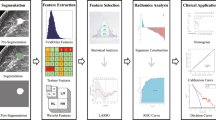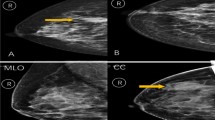Abstract
Background
Accurate prediction of the grade of invasive ductal carcinoma (IDC) before treatment is vital for individualized therapy and improving patient outcomes. This study aimed to develop and validate a mammography-based radiomics nomogram that would incorporate the radiomics signature and clinical risk factors in the preoperative prediction of the histological grade of IDC.
Methods
The data of 534 patients from our hospital with pathologically confirmed IDC (374 in the training cohort and 160 in the validation cohort) were retrospectively analyzed. A total of 792 radiomics features were extracted from the patients’ craniocaudal and mediolateral oblique view images. A radiomics signature was generated using the least absolute shrinkage and selection operator method. Multivariate logistic regression was adopted to establish a radiomics nomogram, the utility of which was evaluated using a receiver-operating characteristic curve, calibration curve, and decision curve analysis (DCA).
Results
The radiomics signature was found to have a significant correlation with histological grade (P < 0.01), but the efficacy of the model is limited. The radiomics nomogram, which incorporated the radiomics signature and spicule sign into mammography, showed good consistency and discrimination in both the training cohort [area under the curve (AUC) = 0.75] and the validation cohort (AUC = 0.75). The calibration curves and DCA demonstrated the clinical usefulness of the proposed radiomics nomogram model.
Conclusions
A radiomics nomogram based on the radiomics signature and spicule sign can be used to predict the histological grade of IDC and assist in clinical decision-making for patients with IDC.





Similar content being viewed by others
Availability of data and materials
The datasets used and/or analyzed during the current study are available from the corresponding author on reasonable request.
Abbreviations
- IDC:
-
Invasive ductal carcinoma
- MRI:
-
Magnetic resonance imaging
- CC:
-
Craniocaudal
- MLO:
-
Mediolateral oblique
- DICOM:
-
Digital imaging and communications in medicine
- PACS:
-
Picture Archiving and Communication System
- ROIs:
-
Regions of interest
- RLM:
-
Run–length matrix
- GLSZM:
-
Gray-level size zone matrix
- GLCM:
-
Gray-level cooccurrence matrix
- LASSO:
-
Least absolute shrinkage and selection operator
- AUC:
-
Area under the curve
- ROC:
-
Receiver-operating characteristic
- DCA:
-
Decision curve analysis
- CESM:
-
Contrast enhancement spectral mammography
References
Aerts HJ, Velazquez ER, Leijenaar RT et al (2014) Decoding tumour phenotype by noninvasive imaging using a quantitative radiomics approach. Nat Commun 5:4006
Ahmeidat H, Purdie C, Jordan L, Fleming D, McCullough J, Evans A (2018) Non-histopathological parameters associated with upgrade of breast tumours yielding a core biopsy report of histological grade 2 ductal no special type to grade 3 on excision. Eur J Surg Oncol 44:1720–1724
Blaichman J, Marcus JC, Alsaadi T, El-Khoury M, Meterissian S, Mesurolle B (2012) Sonographic appearance of invasive ductal carcinoma of the breast according to histologic grade. AJR Am J Roentgenol 199:402–408
Bray F, Ferlay J, Soerjomataram I et al (2018) Global Cancer Statistics 2018:GLOBOCAN estimates of incidence and mortality worldwide for 36 cancers in 185 countries. CA Cancer J Clin 68:394–424
Cui WJ, Wang C, Jia L et al (2019) Differentiation between G1 and G2/G3 phyllodes tumors of breast using mammography and mammographic texture analysis. Front Oncol 9:433
Ding J, Xing Z, Jiang Z et al (2018) CT-based radiomic model predicts high grade of clear cell renal cell carcinoma. Eur J Radiol 103:51–56
Elston CW, Ellis IO (1991) Pathological prognostic factors in breast cancer: I. The value of histological grade in breast cancer: experience from a large study with long-term follow-up. Histopathology 19:403–410
Elston CW, Ellis IO, Pinder SE (1999) Pathological prognostic factors in breast cancer. Crit Rev Oncol Hematol 31:209–223
Gu D, Hu Y, Ding H et al (2019) CT radiomics may predict the grade of pancreatic neuroendocrine tumors: a multicenter study. Eur Radiol 29:6880–6890
Han L, Zhu Y, Liu Z et al (2019) Radiomic nomogram for prediction of axillarylymph node etastasis in breast cancer. Eur Radiol 29:3820–3829
Harris GC, Denley HE, Pinder SE et al (2003) Correlation of histologic prognostic factors in core biopsies and therapeutic excisions of invasive breast carcinoma. Am J Surg Pathol 27:11–15
Huang X, Cheng Z, Huang Y et al (2018) CT-based radiomics signature to discriminate high-grade from Low-grade colorectal adenocarcinoma. Acad Radiol 25:1285–1297
Jung SC, Choi SH, Yeom JA et al (2013) Cerebral blood volume analysis in glioblastomas using dynamic susceptibility contrast-enhanced perfusion MRI: a comparison of manual and semiautomatic segmentation methods. PLoS ONE 8:e69323
Kim SM, Kim Y, Jeong K, Jeong H, Kim J (2018) Logistic LASSO regression for the diagnosis of breast cancer using clinical demographic data and the BI-RADS lexicon for ultrasonography. Ultrasonography 37:36–42
Lamb PM, Perry NM, Vinnicombe SJ, Wells CA (2000) Correlation between ultrasound characteristics, mammographic findings and histological grade in patients with invasive ductal carcinoma of the breast. Clin Radiol 55:40–44
Lambin P, Leijenaar RTH, Deist TM et al (2017) Radiomics: the bridge between medical imaging and personalized medicine. Nat Rev Clin Oncol 14:749–762
Li Z, Yu L, Wang X et al (2018) Diagnostic performance of mammographic texture analysis in the differential diagnosis of benign and malignant breast tumors. Clin Breast Cancer 18:e621–e627
Liang W, Yang P, Huang R et al (2019) A combined nomogram model to preoperatively predict histologic grade in pancreatic neuroendocrine tumors. Clin Cancer Res 25:584–594
Limkin EJ, Sun R, Dercle L et al (2017) Promises and challenges for the implementation of computational medical imaging (radiomics) in oncology. Ann Oncol 28:1191–1206
Liu Y, Zhang Y, Cheng R et al (2019) Radiomics analysis of apparent diffusion coefficient in cervical cancer: a preliminary study on histological grade evaluation. J Magn Reson Imaging 49:280–290
Liu Z, Wang S, Dong D et al (2019) The Applications of radiomics in precision diagnosis and treatment of oncology: opportunities and challenges. Theranostics 9:1303–1322
Ma W, Zhao Y, Ji Y et al (2019) Breast cancer molecular subtype prediction by mammographic radiomic features. Acad Radiol 26:196–201
Mandó P, Rizzo M, de la Puente CP et al (2017) High histologic grade and high Ki-67 expression predict phenotypic alterations in node metastasis in primary breast cancers. J Breast Cancer 20:170–175
Mao N, Jiao Z, Duan S et al (2021) Preoperative prediction of histologic grade in invasive breast cancer by using contrast-enhanced spectral mammography-based radiomics. J Xray Sci Technol 29:763–772
Petrillo A, Fusco R, Di Bernardo E et al (2022) Prediction of breast cancer histological outcome by radiomics and artificial intelligence analysis in contrast-enhanced mammography. Cancers (basel) 14:2132
Rakha EA, Reis-Filho JS, Baehner F et al (2010) Breast cancer prognostic classification in the molecular era: the role of histological grade. Breast Cancer Res 12:207
Rakha EA, El-Sayed ME, Lee AH et al (2018) Prognostic significance of Nottingham histologic grade in invasive breast carcinoma. J Clin Oncol 26:3153–3158
Roknsharifi S, Fishman MDC, Agarwal MD, Brook A, Kharbanda V, Dialani V (2019) The role of diffusion-weighted imaging as supplement to dynamic contrast enhanced breast MRI: Can it help predict malignancy, histologic grade and recurrence? Acad Radiol 26:923–929
Schrading S, Kuhl CK (2008) Mammographic, US, and MR imaging phenotypes of familial breast cancer. Radiology 246:58–70
Siegel RL, Miller KD, Jemal A (2019) Cancer statistics, 2019. CA Cancer J Clin 69:7–34
Steyerberg EW, Vickers AJ (2008) Decision curve analysis: a discussion. Med Decis Making 28:146–149
Tian Q, Yan LF, Zhang X et al (2018) Radiomics strategy for glioma grading using texture features from multiparametric MRI. J Magn Reson Imaging 48:1518–1528
Vasquez MM, Hu C, Roe DJ, Chen Z, Halonen M, Guerra S (2016) Least absolute shrinkage and selection operator type methods for the identification of serum biomarkers of overweight and obesity: simulation and application. BMC Med Res Methodol 16:154
Wang H, Hu D, Yao H et al (2019) Radiomics analysis of multiparametric MRI for the preoperative evaluation of pathological grade in bladder cancer tumors. Eur Radiol 29:6182–6190
Wang Q, Li Q, Mi R et al (2019) Radiomics nomogram building from multiparametric MRI to predict grade in patients with glioma: a cohort study. J Magn Reson Imaging 49:825–833
Yang J, Wang T, Yang L et al (2019) Preoperative prediction of axillary lymph node metastasis in breast cancer using mammography-based radiomics method. Sci Rep 9:4429
Zhang X, Xu X, Tian Q et al (2017) Radiomics assessment of bladder cancer grade using texture features from diffusion-weighted imaging. J Magn Reson Imaging 46:1281–1288
Zheng K, Tan JX, Li F et al (2018) Clinicopathologic factors related to the histological tumor grade of breast cancer in western china: an epidemiological multicenter study of 8619 female patients. Transl Oncol 11:1023–1033
Funding
This research did not receive any specific grant from funding agencies in the public, commercial, or not-for-profit sectors.
Author information
Authors and Affiliations
Contributions
XCR collected and interpreted the patient data, and was a major contributor in writing the manuscript.YHK collected the data and wrote the first draft. GFS, ZGL and GY proposed and designed the study. JLR and YHL analyzed the data. All authors read and approved the final manuscript.
Corresponding authors
Ethics declarations
Conflict of interest
The authors declare that they have no competing interests.
Ethics approval and consent to participate
The retrospective study was approved by ethics committee of the Fourth Hospital of Hebei Medical University (no. 2020KY271). As patient consent to review their medical records was not required by the ethics committee, because the study is retrospective and does not involve patient privacy, the signed informed consent requirement was waved. This study was conducted in accordance with the declaration of Helsinki and patients’ data confidentiality.
Consent for publication
All participants signed a document of informed consent.
Additional information
Publisher's Note
Springer Nature remains neutral with regard to jurisdictional claims in published maps and institutional affiliations.
Rights and permissions
Springer Nature or its licensor (e.g. a society or other partner) holds exclusive rights to this article under a publishing agreement with the author(s) or other rightsholder(s); author self-archiving of the accepted manuscript version of this article is solely governed by the terms of such publishing agreement and applicable law.
About this article
Cite this article
Rong, XC., Kang, YH., Shi, GF. et al. The use of mammography-based radiomics nomograms for the preoperative prediction of the histological grade of invasive ductal carcinoma. J Cancer Res Clin Oncol 149, 11635–11645 (2023). https://doi.org/10.1007/s00432-023-05001-9
Received:
Accepted:
Published:
Issue Date:
DOI: https://doi.org/10.1007/s00432-023-05001-9




